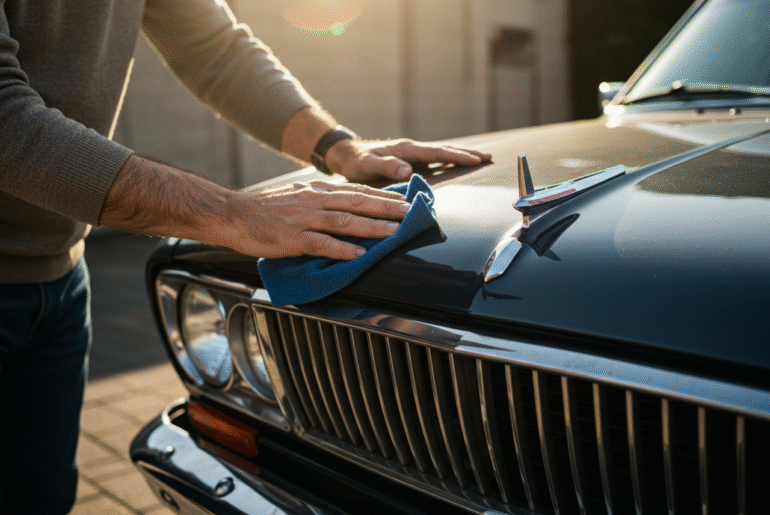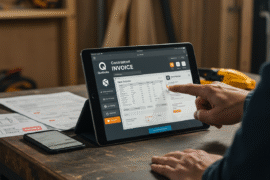This article may contain references to products or services from one or more of our advertisers or partners. We may receive compensation when you click on links to those products or services. Nonetheless, our opinions are our own.
The information presented in this article is accurate to the best of our knowledge at the time of publication. However, information is subject to change, and no guarantees are made about the continued accuracy or completeness of this content after its publication date.
Key Highlights
- Insurance costs for older cars depend on factors like the model year, car value, and safety features.
- Insurance rates for older vehicles can be lower than for newer ones. The price is based on your driving history, where you live, and the coverage you select.
- Classic car insurance offers agreed-upon value coverage for special and vintage cars. That feature sets it apart from regular policies.
- Insurance prices are influenced by state minimums, laws, and local risks.
- Checking car insurance quotes online helps you find the best deal for your needs.
Introduction
Insurance for older cars is changing. You may need full coverage or just a basic policy. Many factors influence the prices and options available. It is important to understand the special value of older cars and how their insurance differs from new cars. Car insurance does not always meet the needs of classic or collectible vehicles. The cost of insurance depends on how you use the car, its condition, and the rules set by the insurance company.
Understanding Insurance for Older Vehicles
Insurance plans for older cars differ from those for newer vehicles. These are often referred to as “classic car insurance” or “vintage vehicle coverage.” These plans are designed for important or seldom-used vehicles. Because these cars receive less driving and are considered special, owners can save money with lower premiums. However, premiums can vary based on the car’s restoration, modifications, or value to collectors.
Older cars that are well maintained are less likely to be stolen or require major repairs, especially when stored safely. If your car is a collector’s item or has high mileage, it is important to select the right insurance. This procedure ensures both savings and protection for your vehicle.
Why Old Car Insurance Matters
Insurance for older cars ensures that vehicles with special or historical value receive the proper coverage. Classic car insurance focuses on agreed-value coverage, which provides protection against depreciation.
Unlike regular car insurance, these plans often limit the number of miles driven. Since these vehicles are not used daily, these limits help reduce costs. Additionally, insurance companies may require proof of safe storage to minimize risks.
For collectors and enthusiasts, these special rules matter greatly. They provide benefits that help protect valuable cars while reducing costs. Car owners should explore classic car insurance options that reflect the value and use of their vehicles.
Comparing Old Car vs. New Car Insurance
Insurance for old and new cars differs in several key ways. Policies for older cars often use agreed-value terms, meaning the vehicle’s value is based on its age or its status as a special car. In contrast, new car insurance generally considers market value, which drops over time.
Liability coverage applies to all vehicles, but the costs can vary. Newer cars often have higher premiums due to better features and more expensive repairs.
Roadside assistance coverage may differ. Newer cars usually have additional features, while older cars, like vintage models, might require special assistance. Selecting the appropriate coverage based on your vehicle’s needs can help balance safety and cost.
What Affects Old Car Insurance Prices?
Several factors influence insurance costs for older vehicles, including the model year, car value, and claims history. Typically, older cars have lower premiums, but this can change depending on upgrades, safety features, and usage.
Local risk factors, state coverage rules, and regional laws can all affect prices. Understanding these factors can help you find the best rates while ensuring adequate coverage.
Vehicle Age and Model
The model year of a vehicle significantly impacts its insurance costs. Older cars usually have lower market values, resulting in cheaper premiums for both accident and full coverage. As a car’s value decreases, full coverage may no longer be cost-effective.
Classic or collectible vehicles may have higher values, which the owner and insurer agree upon. Restored or modified cars may also be pricier to insure due to their collectible nature.
Safety features and maintenance records play a significant role in premiums. Older cars may lack modern safety technology, but regular maintenance can reduce risks. Comparing policies from different insurers is a beneficial way to ensure you have enough coverage for your car’s true value.
Claims History and Safety Ratings
Your driving record and your car’s safety ratings have a major impact on your insurance costs. Cars without modern safety features, such as airbags or advanced braking systems, are often considered riskier, leading to higher premiums.
Insurance companies use past claims data for specific car models. If certain cars have a history of frequent accidents or thefts, they may be deemed risky, leading to higher premiums. A clean driving record is an effective way to lower your rates.
Regional Risk Factors and Insurance Regulations
Insurance laws vary by state, determining how much coverage is required and affecting premiums. Cities generally have higher rates due to increased traffic and a greater risk of accidents.
Weather-related risks, such as flooding or snowstorms, can also raise premiums. Insurers adjust rates to cover damage claims linked to local weather patterns.
Staying informed about local regulations ensures you have the necessary legal protection. Working with insurers familiar with your area can help you find the best rates and potential discounts.
Voted "Best Overall Budgeting App" by Forbes and WSJ
Monarch Money helps you budget, track spending, set goals, and plan your financial future—all in one app.
Get 50% OFF your first year with code MONARCHVIP
Beginner’s Guide to Buying Old Car Insurance
Purchasing insurance for older cars requires careful planning. Start by gathering necessary documents, such as proof of ownership and vehicle information.
Next, seek companies that specialize in classic car insurance. Comparing prices and coverage options will help you select the best policy for your needs.
Required Documents and Information
Ensure you have all necessary documents, including proof of ownership, vehicle make and model, and the VIN. If purchasing from a private seller, obtain a bill of sale and verify ownership to avoid delays.
Having the correct paperwork increases your chances of obtaining the best coverage.
Choosing a Reliable Insurance Provider
Look for insurance companies that offer coverage specifically for classic or vintage vehicles. These companies often provide agreed-value policies and special terms for collectors.
Review customer feedback to evaluate the service quality and claims handling. A company with positive reviews enhances your experience.
Comparing rates and options from different insurers will help you secure the best deal while maintaining adequate coverage.
How to Buy Insurance: Step-by-Step
Step 1: Identify Your Coverage Needs
Consider how you use your vehicle and its value. Older cars may not require damage coverage, but accident and uninsured driver coverage remain important. Factor in local risks and legal requirements to create an affordable, comprehensive plan.
Step 2: Compare Online Quotes
Use online tools to obtain quotes and explore coverage options. Trusted sources like Quadrant Information Services provide reliable data to guide your decisions.
Step 3: Explore Discounts and Offers
Insurance providers often offer discounts for excellent credit, safe vehicles, or low-mileage drivers. Look for loyalty programs, multi-policy discounts, and savings for students or safe drivers.
Step 4: Finalize and Purchase Your Policy
Please provide the necessary documentation and review the policy details before completing your purchase. Ensure there is no overlap with existing coverage to avoid unnecessary charges.
Proper preparation helps protect your older car from unexpected issues.
How Market Trends Influence Old Car Insurance
Emerging trends are reshaping how insurance works for older vehicles. Advances in technology and shifts in the economy are affecting both pricing and the quality of service offered to customers.
The Role of Technology
Modern tools like GPS tracking and telematics provide insurers with better data to assess risk. These digital services simplify policy management and help reduce premiums.
Telematics programs reward safe driving, offering personalized premiums based on how an individual drives.
Economic Trends Affecting Pricing
Economic factors, such as inflation, impact insurance costs, particularly for cars requiring specialized repairs or hard-to-find parts.
Insurance companies track consumer spending patterns and adjust prices accordingly. Local tax changes and added fees can also influence premiums.
Staying informed helps vehicle owners manage price fluctuations and maintain adequate coverage.
Conclusion
Understanding what affects the price of old car insurance is essential. Key factors include vehicle age, model, claims history, and regional risks. By staying updated on market trends and comparing quotes, you can secure the best deal for your car.
If needed, consult an insurance expert to receive personalized advice that suits your specific needs.
Frequently Asked Questions
Is insurance cheaper for older cars?
Yes, older cars often have cheaper insurance premiums due to their lower market value. However, the cost can vary depending on safety features, claims history, and the type of coverage chosen. Classic cars may require specialized insurance with agreed-upon value coverage.
How often should I review my old car insurance policy?
Review your policy annually to ensure adequate coverage and competitive rates. If you change how you use your car or if local regulations change, reassess your policy to ensure it reflects these changes.
Can I get full coverage for my classic car?
Yes, many insurance companies offer full coverage for classic cars, but the terms often differ from regular policies. These plans typically include agreed-value coverage, which protects the car based on its collectible value rather than market depreciation.
What are the main differences between classic car insurance and regular car insurance?
Classic car insurance generally has mileage limits, specialized repair coverage, and agreed-value terms, while regular insurance covers the actual cash value of the vehicle, factoring in depreciation.

Reviewed and edited by Albert Fang.
See a typo or want to suggest an edit/revision to the content? Use the contact us form to provide feedback.
At FangWallet, we value editorial integrity and open collaboration in curating quality content for readers to enjoy. Much appreciated for the assist.
Did you like our article and find it insightful? We encourage sharing the article link with family and friends to benefit as well - better yet, sharing on social media. Thank you for the support! 🍉
Article Title: What’s Influencing Old Car Insurance Prices? Key Trends to Watch
https://fangwallet.com/2025/05/12/old-car-insurance/The FangWallet Promise
FangWallet is an editorially independent resource - founded on breaking down challenging financial concepts for anyone to understand since 2014. While we adhere to editorial integrity, note that this post may contain references to products from our partners.
The FangWallet promise is always to have your best interest in mind and be transparent and honest about the financial picture.
Become an Insider

Subscribe to get a free daily budget planner printable to help get your money on track!
Make passive money the right way. No spam.
Editorial Disclaimer: The editorial content on this page is not provided by any of the companies mentioned. The opinions expressed here are the author's alone.
The content of this website is for informational purposes only and does not represent investment advice, or an offer or solicitation to buy or sell any security, investment, or product. Investors are encouraged to do their own due diligence, and, if necessary, consult professional advising before making any investment decisions. Investing involves a high degree of risk, and financial losses may occur including the potential loss of principal.
Source Citation References:
+ Inspo
There are no additional citations or references to note for this article at this time.












































